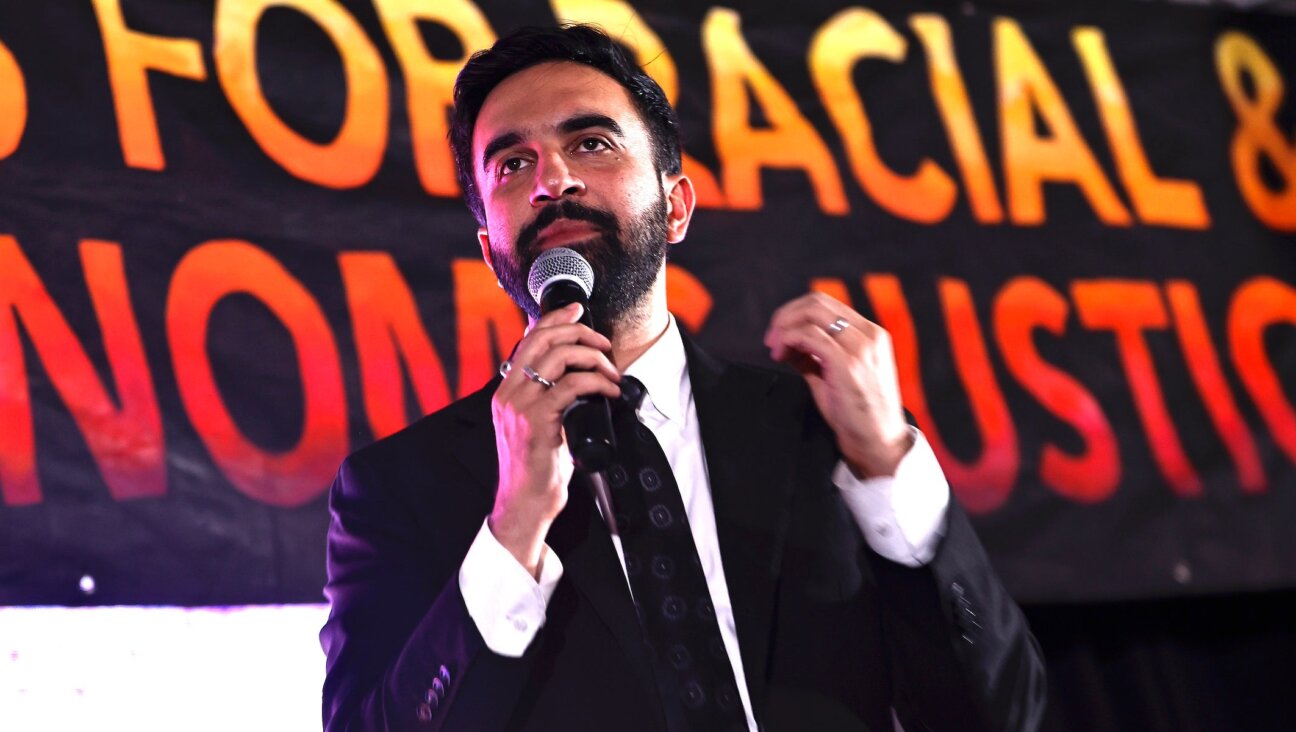The Other Intermarriage Crisis

Image by Dana V’Ron YouTube
The seven couples sat in a circle staring at each other warily.
Many of them had come to the gathering with deep reservations, but also a sense of hope that it would be the start of something better. All of them were grappling with a strong sense of being stuck between two worlds.
One of the women began to speak, describing how she had recently begun increasing her level of religious observance. Sitting next to her with his arms crossed and a scowl on his face, her husband of thirty years burst out that he didn’t understand where her newfound faith had come from and that it was a disruptive force in their relationship.
The next couple — comprised of a woman dressed in the ultra-conservative outfit of a Hasidic Jew and a man wearing khakis, a black T-shirt and a baseball cap — had a similar story, with the husband complaining that while he did not necessarily object to his wife’s desire to become more religiously observant, the changes were too much, too soon. “The kids are Haredi. I feel alone,” he told the group, explaining how he supported his wife’s decision to send his children to ultra-Orthodox schools but still felt that they had “advanced too much” while he “stayed behind with nothing to hold onto.”
“I was left up in the air,” he complained.
While it isn’t uncommon to find Orthodox Israelis who have left religion or secular Israelis who have embraced it, marriages between the two religious subgroups remain extremely rare. According to a Pew Research Center report on Israeli religious trends released in 2016, more than four out of five Israelis are married to members of their own religious stream, with that number rising to nearly one hundred percent when it comes to Haredim and secular Jews. The two groups are deeply distrustful of each other and the marriage rate between them hovering at around one percent. Between secular and “national religious” Jews, the rate rises to three percent.
All of the couples at the meeting, which was the introductory session in a 17-part workshop run by the NGO Hitkashroot (Hebrew for “attachment”), belonged to this extremely small demographic subgroup. Founded fifteen years ago by Ami Baram, Hitkashroot attempts to find common ground and preserve marriages in which one partner unilaterally changed his or her religious affiliation.

Ami Baram, founder of Hitkashroot, with his wife Avital. Ami was Orthodox for ten years alone, before Avital chose to become religious as well. Image by Hitkashroot
Raised as a secular Jew in north Tel Aviv, Ami was on the typical Israeli track. High school was followed by the army which was followed by university — nothing out of the ordinary. It was only after several years of marriage that he began to explore his Judaism, gradually making the transition to becoming an ultra-Orthodox Jew. His wife, while she would eventually also take the same path, was initially taken aback and for the first ten years of their marriage they lived as a mixed couple, with no guide and little precedent.
“My wife didn’t understand from where this fell on her,” he said, adding that while this “twenty years ago it was pretty unusual,” now it is a little more common, with potentially up to several thousand couples in Israel in which one partner is secular and the other is either modern Orthodox or Haredi. Surprisingly, despite all of the myriad difficulties inherent in such a relationship, one of the most difficult things for his wife to handle was his decision to grow a long beard, he added.
Around five years after first becoming religious, Ami established what would eventually become Hitkashroot, taking the lessons that he had picked up piecemeal from various places and building a coherent program to aid those going through a similar process. Over time, the NGO became increasingly professional, integrating sessions with a rabbi and a secular psychologist married to a religiously observant man.

A support group for secular-religious couples in Israel, run by Hitkashroot. Image by Hitkashroot
“People come with crisis in their relationships and the first thing we have to do is to give them hope — [both] those who became religious and for those who left religion — that it’s okay.”
Like Ami, Einav Levin is one half of a mixed couple. A secular woman married to a religious husband, Levin is in charge of Hitkashroot’s mixed-couples community, a social group comprised of graduates of the organization’s courses which gets together on a regular basis and communicates through dedicated Facebook and WhatsApp groups.
The core values taught at Hitkashroot, similar to many more traditional marriage counseling programs, are communications and mutual respect, she explained, citing her own marriage as an example. While her husband Erez first began to explore religion, putting on Tefillin every day and making Kiddush on Friday evenings, she liked it, seeing it bring out a spiritual side in him. It was only when this spirituality transformed into observance of religious precepts such as not driving on Shabbat that things began to get complicated. Friends, put off by the changes, stopped coming by to their house, previously a center of activity within their social circle. Tensions began creeping into their marriage.
“It took me three years to get the idea that we can have children although we are very different in terms of religious points of view,” she said. “The first years of marriage were like hell. It was so hard to build a home with a person who was [in the middle of such] a process.”
For Einav, who loved to go out on weekend trips, Shabbat was the biggest stumbling block. Eventually, however, she and Erez developed a modus vivendi in which she looked at “what he needs for Shabbat and he sees what I need for my secular issues and he takes care of it.” Erez would arrange family trips for Fridays while Einav would prepare Shabbat. After the Friday night meal, the couple would go out into their back yard and relax, Erez with a book of Torah thoughts and Einav with a cigarette and smartphone.
“He can sit with me in our garden and read the weekly portion, and I’m on my mobile and when the children are sleeping I’m smoking and we are studying together. I’m not Shabbat observant at all, and he is very observant, but he accepts me with my cigarettes on Friday night and I accept his weekly Torah reading, and I’m interested in his reading because I know it’s his world now and I want to know his world. I don’t want us to live in separate worlds.”
Though the mission of Hitkashroot, which pointedly does not advocate for spouses to either increase or decrease their level of observance, stands at odds with the Haredi establishment — there are rabbis who quietly refer members of the communities to the organization. Most of Hitkashroot’s clients discover the support group through word of mouth, Einav said.
Among the couples to go through the program were Amit and Eric Brown from Modiin. Now in their late forties, the pair met during their army service in the early nineties, when they were both officers on the same IDF base. A typical army couple, they started off as friends, fell in love and moved in together, eventually marrying and living an average secular life.
Amit, who grew up in the left-wing HaShomer HaTzair movement, was, as she described it, “very secular” but eventually found her way to religious practice following a protracted spiritual quest that eventually led her to Kabbalah.
“It was a very, very slow process to become religious,” she said. “I decided to make it slow. It was very important for me to keep the family together and happy since they don’t see the world the way I do.”
Despite her efforts, however, Eric’s initial reaction was to split up.
“It was very difficult. In the beginning didn’t see how it could work,” he said. “We didn’t fight a lot, but we had a lot of discussions and talks about it and eventually we decided to give it a try. She tried to make it as easy as she could for us. She didn’t force us to not drive on Saturday or not use our phones or tablets. For us, Shabbat was the main issue and the kids and I are still doing almost everything the same as before, except for traveling as a family.”
Hitkashroot, he added, was a “big gift” because they didn’t know how to make their relationship work but knew they wanted to keep the family together. Beyond the workshops, one of the main advantages of the program was the community it fostered because it provided them and their children a chance to speak with others grappling with similar issues.
One would think that some of of the primary barriers to such “interfaith” marriages would be kashruth and the laws of family purity, which stipulate that couples refrain from relations two weeks out of the month, only resuming sexual activity after the wife immerses herself in the mikvah. However, it appears that many of the couples are more concerned with Shabbat restrictions, given the social nature of the day in secular Israeli society, and with questions of how to educate their children.
Motti Idan, a hi-tech worker from Raanana, met his wife in a club on a Friday evening in 1998. From the beginning, she knew he had an attraction to religion and asked him to reassure her he wouldn’t become Orthodox. It was a promise he couldn’t keep. While the laws of family purity didn’t particularly faze her, Shabbat proved a sticking point. As for education, Motti said that he treats his children as he treats his wife.
“I don’t ask them to do something they don’t want. They make kiddush on Shabbat and they can put the TV on but I don’t see it. I’m in synagogue or the study hall. I don’t ask what them what they do with their free time when I’m not there.”
Citing a couple that he worked with in which the wife is an atheist and the husband a Breslov Hasid, Kitkashroot’s Ami said that the secret to a successful mixed marriage is the same as a regular one. “When couples come here they get to understand that you have needs and I have needs. Our interests are that your needs get served and my needs get served,” he said.
Einav agreed, saying that there is a need in such relationships to “show the children that mommy and daddy are the same side, that they are not fighting over you. And if we choose a school that is not religious, it is because both of us are thinking that this is the best way for you to go. It’s not ‘Mommy decides and Daddy needs to understand.’ No, both of us decided, together.”
Sam Sokol is a freelance journalist based in Israel. A former Jerusalem Post and IBA News correspondent, he is currently writing a book on the destruction of the Jewish communities of eastern Ukraine.
















